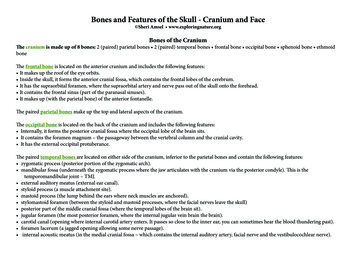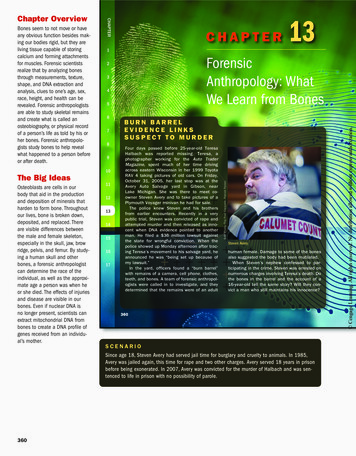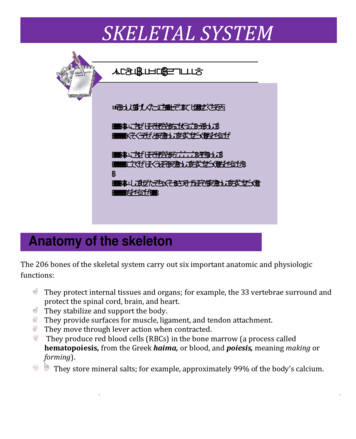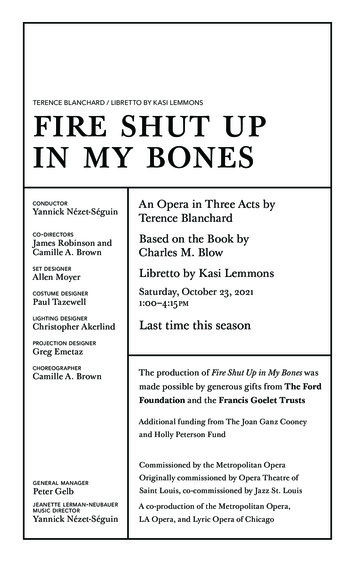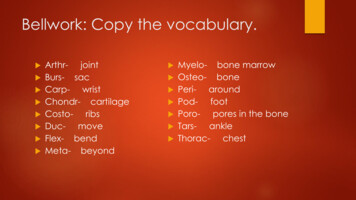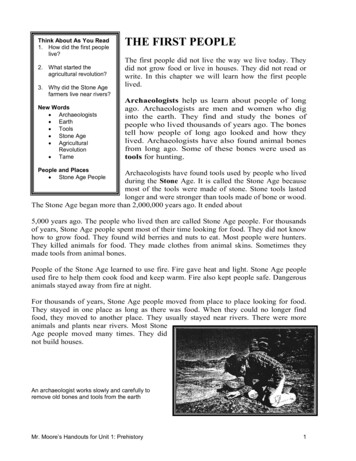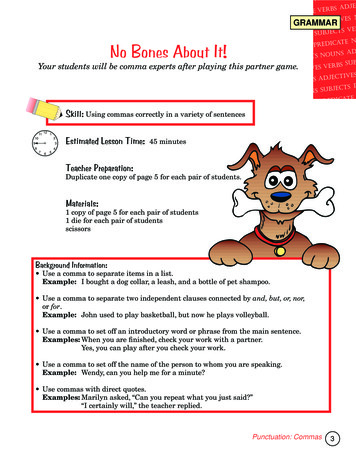
Transcription
NADJECE VERBSES NADJECTIVGRAMMARNo Bones About It!Your students will be comma experts after playing this partner game.VERSUBJECTSE NPREDICATS ADTS NOUNS SUBVES VERBTIVESTS ADJECECTS PNS SUBJEPREDICATSkill: Using commas correctly in a variety of sentences111212109 876 Estimated Lesson Time:45 minutes Teacher Preparation:Duplicate one copy of page 5 for each pair of students.Materials:1 copy of page 5 for each pair of students1 die for each pair of studentsscissorsBackground Information: Use a comma to separate items in a list.Example: I bought a dog collar, a leash, and a bottle of pet shampoo. Use a comma to separate two independent clauses connected by and, but, or, nor,or for.Example: John used to play basketball, but now he plays volleyball. Use a comma to set off an introductory word or phrase from the main sentence.Examples: When you are finished, check your work with a partner.Yes, you can play after you check your work. Use a comma to set off the name of the person to whom you are speaking.Example: Wendy, can you help me for a minute? Use commas with direct quotes.Examples: Marilyn asked, “Can you repeat what you just said?”“I certainly will,” the teacher replied.Punctuation: Commas
NOUDJECTVERBS AS SUBJECS VERBSES VADJECTIVPRESUBJECTSE NOPREDICATIntroducing The Lesson:Begin the lesson by reviewing the five comma rules in “Background Information” on page 3. Share the examples for each rule.Steps:1. Pair up students and give each pair a copy of page 5. Provide eachpair with scissors and a die.2. Instruct each student to number a sheet of notebook paper 1–15.Then instruct each pair to cut out each card on page 5.3. Have each pair shuffle its cards and place them facedown in a pile.To play the game, have one student in each pair turn over a card,then roll the die to determine a point value.4. Next tell each student to write the point value in the left marginnext to the number on his paper that matches the number on thecard drawn from the pile. Then instruct each student in the pair torewrite the sentence from the card next to the matching number onhis paper, inserting the missing commas.5. Have students take turns turning over cards and rolling the die until no cards remain.6. Have partners switch papers; then as a class go over the correctanswers to each card. Tell each partner to circle the point value infront of each correct answer. Next have both partners add up thepoints that were circled. Declare the pair with the most points thewinner.Score8 Punctuation: Commas1.2.3.4.retract their toenails.5. Unlike cats, dogs cannot6.7.8.9.10.11.12.13.14.15.
1.2.3.German shepherds Chihuahuas and basenjis have earsthat are pointed and standstraight up.Kara do you believe that bloodhounds can follow scent trailsmore than four days old?Guard hairs fine hairs andtactile hairs are the three basictypes of hair in a dog’s coat.4.5.6.At the back of each eye a doghas a mirrorlike structure thathelps the animal see in dimlight.Unlike cats dogs cannot retract their toenails.The vet said “Do not feed yourdog any table scraps.”7.8.9.Charleton do you want to gooutside for a walk?A dog’s coat may consist ofseveral colors and membersof the same breed may havedifferent-colored coats.Cocker spaniels Labrador retrievers poodles and beagleshave long, hanging ears.10.11.12.Dogs often bury bones or theymay simply dig holes.“Yes the basenji is the only dogthat cannot bark” remarkedTisha.Bone chewing is natural fordogs but it can cause brokenteeth.13.14.15.“The dog” John commented “isan animal that has lived withpeople as a pet for more than10,000 years!”Yes dogs can hear much better than people can.Some dogs are born with longtails but a veterinarian maydock (cut off) their tails shortlyafter birth. 1997 The Education Center, Inc. Lifesaver Lessons Grade 5 TEC496 Key p. 95
NOUDJECTVERBS AS SUBJECS VERBSES VADJECTIVPRESUBJECTSE NOPREDICATHow To Extend The Lesson: Have each student write a creative narrative involving a dog. Instructstudents to use commas whenever necessary in their writings. Ontheir rough drafts, have students highlight or underline with a coloredpen each sentence that contains a comma. Write a variety of the highlighted sentences on overhead transparencies, removing the commas.Use the transparencies to review commas at a later time by havingstudents insert the missing commas. Divide the class into groups of five. Have a contest to see how manysentences each group can find using the five comma rules reinforcedin this lesson. Instruct each student in each group to choose one ofthe five comma rules. Tell each student he has 15 minutes to use textbooks, novels, or other written material to find at least two sentencesthat use the particular comma rule chosen. Each student is responsible for writing down each sentence on a sheet of notebook paper. Reward one point for each correct sentence and declare the team with themost points the winner. Challenge students to find commas used in sentences where the fiverules from this lesson don’t apply. Tell students to each record in ajournal sentences that use commas in ways other than the five rulesdiscussed in this lesson. After a week, have each student read one ortwo of his sentences and have the class discuss why the commas wereused. Add new comma rules to the list.Hmm This sentence doesn’tfollow the five comma rules.“The jewel thief, who had enteredthrough the window, went directly to the vault.” Punctuation: Commas
NADJECE VERBSES NADJECTIVGRAMMARConversation PunctuationStudents will definitely have something to talk about after completingthis punctuating quotes activity.Skill: Punctuating direct and divided quotes1112121098 76 VERSUBJECTSE NPREDICATS ADTS NOUNS SUBVES VERBTIVESTS ADJECECTS PNS SUBJEPREDICATEstimated Lesson Time: 45 minutesTeacher Preparation:Duplicate one copy of page 9 for each pair of students.Materials:1 copy of page 9 for each pairold magazinesgluescissorsBackground Information: Quotation marks are used before and after someone’s exactwords. Periods and commas are always inside the quotation marks. Question marks and exclamation points go inside the quotation marks when punctuating the quote; they are placed outsidewhen punctuating the main sentence. When writing dialogue, a new paragraph is begun each time adifferent person speaks.Punctuating quotes
NOUDJECTVERBS AS SUBJECS VERBSES VADJECTIVPRESUBJECTSE NOPREDICATIntroducing The Lesson:Begin this lesson by having two students carry on a dialogue about lunchin front of the class. After a few sentences, have each student who is sitting down cover his ears. After a few more sentences, stop the conversation and ask the class how they could tell who was speaking—lips moving, hand gestures, body language.Steps:1. Next ask students how they know which character in a novel isspeaking when they are reading. Explain that quotation marks areused to set off someone’s exact words and that the name of the person who is speaking is usually placed before or after the quote.2. Discuss each of the following situations where quotation marks areneeded and how each one is punctuated.Direct Quotes:John said, “I can’t believe that we have a test today.”“I can’t believe that we have a test today,” said John.“Can you believe that we have a test today?” said John.“I didn’t study for the test today!” said John.Divided Quotes:“I can’t believe,” said John, “that we have a test today.”“I can’t believe that we have a test today,” said John. “I didn’t study.”3. Assign each child a partner. Give each pair a copy of page 9, an oldmagazine, scissors, and glue. Instruct them to complete the reproducible after reading the directions.4. After 15 or 20 minutes, have each pair swap papers with anotherpair to check for accuracy. Have each pair show its pictures andshare its conversations with the rest of the class.You dida great job! Punctuating quotesSo didyou!
No Bones About It! Background Information: Use a comma to separate items in a list. Example: I bought a dog collar, a leash, and a bottle of pet shampoo. Use a comma to separate two independent clauses connected by and, but, or, nor, or for. Example: J
